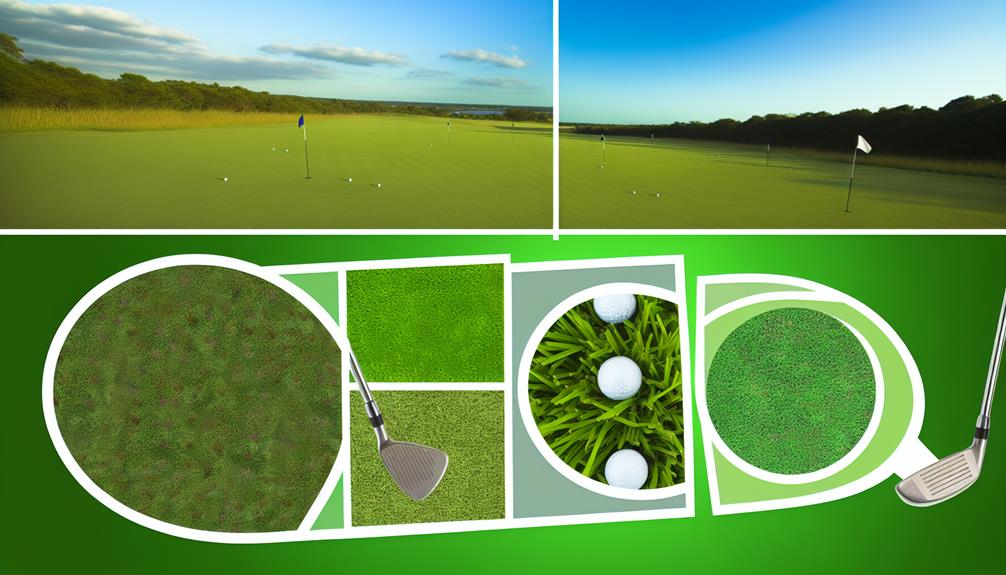Just as a gardener appreciates the nuanced differences between roses and tulips, so too, as a golf enthusiast, should you grasp the subtleties of golf putting green grasses.
The choice of turf can transform your golf experience, influencing the ball's roll and overall playability.
From the widely used Bentgrass to the resilient Bermuda, each grass type has its unique characteristics and advantages.
But which one trumps in creating the perfect putting green? Or does the answer lie somewhere in the balance of multiple grass types?
Let's unpack this intriguing aspect of golf course design that often goes unnoticed.
Understanding Golf Putting Green Grasses
Before diving into the specifics, it's important to understand that the type of grass used on a golf putting green significantly impacts the game's playability and aesthetics. Different grass types have various characteristics that can affect the speed, roll, and overall feel of the ball on the green.
Grass maintenance techniques play a critical role in preserving the ideal playing conditions. Mowing, watering, aerating, and fertilizing are all key components of a comprehensive maintenance routine. Mowing, for instance, should be done regularly to keep the grass at an optimal height, enhancing the ball's roll and speed. Watering keeps the grass hydrated, while aeration helps improve soil structure and root growth. Fertilizing, on the other hand, replenishes essential nutrients, ensuring the grass stays healthy and vibrant.
Ideal climate conditions also influence the choice of grass for a putting green. Some grasses thrive in warm climates, while others prefer cooler conditions. For instance, Bermuda grass is highly tolerant of heat and drought, making it suitable for warm climates. On the contrary, Bentgrass, which favours cooler temperatures, is often used in northern regions. It's essential to choose a grass type that aligns with the local climate for optimal performance and sustainability.
The Importance of Bentgrass
Shifting our focus to Bentgrass, you'll find its significance in golf putting greens is profoundly linked to its unique characteristics and adaptability to cooler climates. Bentgrass offers a dense, fine texture, making it a top pick for providing smooth, fast greens that are a golfer's dream.
Bentgrass maintenance is a crucial factor in its prominence. It's a hardy grass, tolerating low mowing and frequent foot traffic, both common on golf courses. It also responds well to regular aeration, necessary for optimal health on high-traffic golf courses.
Equally important is Bentgrass's disease resistance. While no grass is immune, Bentgrass demonstrates a resilience against common turf diseases, reducing the need for frequent and costly treatments. This makes it a cost-effective choice for many golf courses, particularly those in northern regions with cooler climates.
You'll also appreciate its ability to recover well from damage. Whether it's divots from golf balls or wear and tear from golf carts and foot traffic, Bentgrass bounces back, maintaining the pristine appearance that's essential for a high-quality golf course.
Characteristics of Bermuda Grass
Another prominent grass type for golf putting greens is Bermuda grass, known for its exceptional heat tolerance and vigorous growth habit. This grass thrives in warm climates and can withstand heavy foot traffic, making it ideal for popular golf courses.
Bermuda grass maintenance, however, can be a bit demanding. Regular mowing is essential to maintain a smooth and uniform playing surface. You'll also need to water it frequently to keep it lush and resilient, especially during dry spells. It's important to manage thatch build-up too, as this can affect the grass's health and playability.
When it comes to Bermuda grass diseases, leaf spot and dollar spot are common. Leaf spot occurs when the grass is stressed due to over- or under-watering, while dollar spot manifests as small, round, straw-colored patches. Both can be controlled with proper care and timely fungicide application.
Comparing Ryegrass and Fescue
While Bermuda grass has its advantages, you'll find that both Ryegrass and Fescue offer unique benefits that can make them equally viable options for golf putting greens.
Ryegrass is known for its adaptability, making it an excellent choice for a variety of climates and soil conditions. Its ability to withstand heavy foot traffic and recover quickly from wear and tear serves well for high-use greens. Additionally, Ryegrass germinates rapidly, which means it can establish itself quickly and create a dense, uniform surface that's ideal for putting.
On the other hand, Fescue's strength lies in its sustainability. This cool-season grass has a deep root system that allows it to tolerate drought and requires less watering and maintenance than other grass types. Furthermore, Fescue provides a fine-textured, firm surface with excellent ball roll characteristics, making it an appealing choice for golfers.
The Role of Poa Annua in Putting Greens
Beyond Ryegrass and Fescue, there's another grass type you might encounter on the green – Poa Annua, which plays a significant role in many golf courses worldwide. This cool-season grass, often referred to as annual bluegrass, is renowned for its resilience and adaptability.
Poa Annua's resilience allows it to thrive in a variety of climates and soil conditions, making it a versatile choice for golf courses. It has a high tolerance for cold and wet conditions, and its ability to rapidly recover from damage is unmatched. This makes Poa Annua an attractive option, especially in regions with harsh climates.
However, Poa Annua's maintenance can be challenging. Its rapid growth rate means it requires frequent mowing and watering to maintain its optimal condition. Moreover, it's susceptible to certain lawn diseases which can affect its appearance and health. Therefore, a rigorous maintenance routine is needed to keep this grass in tip-top shape.

